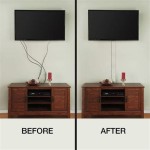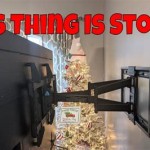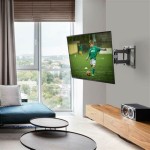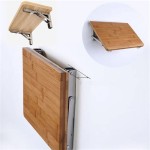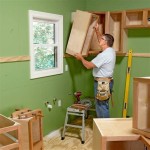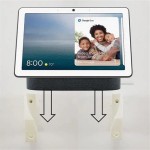Understanding Full Motion TV Wall Mounts with Vertical Adjustment
Television wall mounts have become increasingly popular, offering a space-saving and aesthetically pleasing alternative to traditional TV stands. Among the various types available, the full motion TV wall mount stands out for its versatility. Specifically, full motion mounts with up-and-down (vertical) adjustment provide an enhanced viewing experience, allowing users to optimize their screen position for comfort and clarity, regardless of the room's layout or seating arrangement.
This article will explore the functionalities, advantages, installation considerations, and key selection criteria for full motion TV wall mounts with vertical adjustment capabilities. It aims to provide a comprehensive understanding of these mounts, enabling informed decisions for consumers and installers alike.
Enhanced Viewing Flexibility with Vertical Adjustment
The primary advantage of a full motion TV wall mount with up-and-down adjustment lies in its enhanced viewing flexibility. Standard full motion mounts offer tilt, swivel, and extension capabilities, allowing the television to be angled horizontally and brought closer or further away from the wall. However, the addition of vertical adjustment expands the range of motion, enabling users to raise or lower the TV screen to the optimal viewing height.
This vertical adjustment is particularly beneficial in several scenarios. For example, in rooms with varying seating heights, such as those with couches, recliners, and floor cushions, the screen can be adjusted to maintain a comfortable viewing angle for all occupants. Similarly, in rooms where the television is used for different purposes, such as gaming, exercise, or presentations, the vertical adjustment allows the screen to be positioned for optimal visibility and ergonomics. Furthermore, adjustments can be done to reduce glare from windows or overhead lighting.
The vertical adjustment mechanism typically involves a sliding bracket or gas spring system that allows for smooth and effortless height changes. The range of vertical adjustment varies depending on the specific mount model, but it typically ranges from a few inches to over a foot. This range provides sufficient flexibility to accommodate a wide range of viewing preferences and room configurations.
The ability to fine-tune the screen height is also advantageous for individuals with specific physical needs or disabilities. For instance, users who use wheelchairs or have limited mobility may find it easier to view the screen when it is positioned at a lower height. By allowing for personalized screen positioning, full motion TV wall mounts with vertical adjustment contribute to a more inclusive and comfortable viewing experience.
In addition to enhancing viewing comfort, vertical adjustment can also improve the aesthetics of the room. By allowing the television to be positioned at the optimal height, the mount can help to create a more balanced and harmonious look. This is especially important in rooms where the television is a focal point.
Key Considerations for Selecting a Full Motion Mount with Vertical Adjustment
Selecting the right full motion TV wall mount with vertical adjustment requires careful consideration of several factors. These factors include the TV's weight and size, the wall type, the desired range of motion, and the overall quality and durability of the mount. Ignoring these considerations can result in an unstable or incompatible mount, potentially leading to damage to the television or injury.
Firstly, it's imperative to verify that the mount is compatible with the size and weight of the television. Manufacturers specify a maximum weight capacity and a range of compatible screen sizes for each mount model. Exceeding these limits can compromise the stability of the mount and potentially lead to catastrophic failure. The VESA (Video Electronics Standards Association) mounting pattern on the back of the TV must also match the mount's VESA compatibility. VESA patterns are standardized dimensions of the mounting holes on the back of the TV, and ensuring compatibility is crucial for secure attachment.
Secondly, the wall type is a crucial consideration. Different wall types, such as drywall, wood studs, concrete, and brick, require different mounting hardware and techniques. Drywall, for example, typically requires the use of wall anchors or mounting into wall studs to provide sufficient support. Concrete and brick walls, on the other hand, require specialized drill bits and anchors. It is essential to identify the wall type and select a mount that is specifically designed for it. If unsure, consulting a professional installer is highly recommended.
Thirdly, the desired range of motion should be carefully considered. The range of tilt, swivel, extension, and vertical adjustment will determine the flexibility of the mount and its suitability for different viewing scenarios. Consider the room's layout, seating arrangement, and viewing preferences when determining the necessary range of motion. For example, if the television needs to be viewed from multiple angles, a mount with a wide swivel range is essential. Similarly, if the television needs to be raised or lowered significantly, a mount with a wide vertical adjustment range is required.
Fourth, the quality and durability of the mount are paramount. Look for mounts that are made from high-quality materials, such as steel, and that have a robust construction. Read reviews from other users to get an idea of the mount's reliability and performance. A higher-quality mount may cost more initially, but it will provide greater peace of mind and ensure the long-term safety and stability of the television.
Finally, consider any additional features that may be desirable. Some mounts include cable management systems to help keep wires organized and hidden. Others have built-in bubble levels to ensure that the television is mounted straight. Still others feature quick-release mechanisms that allow for easy removal of the television for maintenance or replacement. These features can add convenience and value to the mount.
Installation Best Practices for Full Motion Mounts
Proper installation is critical for ensuring the safety and functionality of a full motion TV wall mount. Incorrect installation can compromise the stability of the mount and potentially lead to damage to the television or injury. While some individuals may be comfortable installing the mount themselves, it is often recommended to hire a professional installer, especially for larger or heavier televisions or for installations on challenging wall types.
The first step in the installation process is to carefully read and follow the manufacturer's instructions. The instructions will provide specific guidance on the necessary tools, hardware, and procedures for installing the mount. Before starting the installation, gather all the necessary tools and hardware, and ensure that you have a clear and unobstructed work area.
The next step is to locate the wall studs. Wall studs are vertical beams within the wall that provide structural support. Finding the studs is essential for securely mounting the bracket. A stud finder can assist in locating the studs. Once the studs are located, mark their positions on the wall. Use a level to ensure that the marks are straight.
Position the mounting bracket against the wall, aligning it with the marked stud locations. Use a drill to create pilot holes through the bracket and into the studs. Then, attach the bracket to the wall using the appropriate screws or bolts. Ensure that the bracket is securely fastened and that it is level. Use shims if necessary to level the bracket.
Attach the TV brackets to the television, ensuring that they are properly aligned with the VESA mounting holes. Use the correct size screws to attach the brackets. Do not overtighten the screws, as this could damage the television. Once the TV brackets are attached, carefully lift the television and attach it to the mounting bracket on the wall. Secure the television to the mount using the appropriate hardware.
After the television is mounted, test the range of motion of the mount. Ensure that the television can be tilted, swiveled, extended, and vertically adjusted smoothly and easily. If any adjustments are necessary, make them before finalizing the installation.
Finally, organize the cables and wires. Use cable ties or cable organizers to keep the wires neat and tidy. Hide the wires behind the television or run them through the wall if possible. This will improve the aesthetics of the installation and prevent the wires from becoming tangled or damaged.
It's crucial to regularly inspect the mount and hardware after installation to ensure that all connections remain secure. Over time, vibrations or movement can cause screws to loosen, potentially compromising the stability of the mount. Periodically tightening the screws and checking for any signs of wear or damage will help to maintain the safety and functionality of the mount. Do not attempt the mounting alone, always seek assistance to prevent accidents and damages to the TV.

Up And Down Tv Full Motion Motorized Mantel Wall Mount For Max 100 Inch Large Whole Brackets Made In China Com

Mono 42in To 65in Above Fireplace Pull Down Full Motion Articulating Tv Wall Mount Installation

650346 60 100 Interactive Up Down Tv Wall Mount Levelone

The Best Full Motion Tv Mounts Mount It

Full Motion Swivel Tv Wall Mount Bracket For 40 85 Inch Simple Joys

360 Degree Swing Down Cantilever Full Motion Lcd Tv Monitor Spring Arm Wall Mount Atw20m Highgrade Tech Co Ltd

Up And Down Tv Full Motion Motorized Mantel Wall Mount For Max 100 Inch Large Whole Brackets Made In China Com

Dy638d Best Full Motion Move Up And Down Tv Wall Mount Bracket For 37 86 Inch Most Brand

Up And Down Tv Full Motion Motorized Mantel Wall Mount For Max 100 Inch Large

S Tv Pipishell Full Motion Mount Fits 37 75 Tvs Up To 132lbs Swivel Tilt Wall Inch

